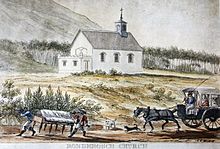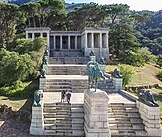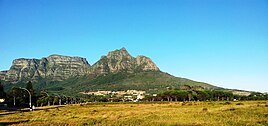Rondebosch
Rondebosch | |
|---|---|
 | |
| Coordinates:33°57′48″S18°28′35″E/ 33.96333°S 18.47639°E | |
| Country | South Africa |
| Province | Western Cape |
| Municipality | City of Cape Town |
| Main Place | Cape Town |
| Area | |
| • Total | 6.42 km2(2.48 sq mi) |
| Population (2011)[1] | |
| • Total | 14,591 |
| • Density | 2,300/km2(5,900/sq mi) |
| Racial makeup (2011) | |
| •Black African | 16.5% |
| •Coloured | 9.6% |
| •Indian/Asian | 6.1% |
| •White | 62.7% |
| • Other | 5.0% |
| First languages(2011) | |
| •English | 84.3% |
| •Afrikaans | 7.6% |
| •Xhosa | 1.8% |
| • Other | 6.3% |
| Time zone | UTC+2(SAST) |
| Postal code(street) | 7700 |
| PO box | 7701 |
| Area code | (021) 685/686 |
Rondeboschis one of theSouthern SuburbsofCape Town,South Africa.It is primarily a residential suburb, with shopping and business districts as well as the main campus of theUniversity of Cape Town.[2]
History
[edit]
Four years after the first Dutch settlement at the Cape in 1652, the first experimental crops were grown along the banks of theLiesbeek River(at that stage called the Amstel or Versse Rivier).[citation needed]In October 1656,Jan van Riebeeckvisited Rondeboschyn, whose name derived from a contraction of "Ronde Doorn Bossien,"referring to a circular grove of thorn trees growing on the banks of the Liesbeek River.[2][3][4]By 1670 the area's name had been shortened to "Rondeboschje"in theDutch East India Company's (VOC) records.
In 1657, the first group of VOC employees gainedfree burgherstatus, four of whom were granted land along the river and founded "Stephen's Colony"in the area now known as Rondebosch.[5]The first permanent title of land in southern Africa was issued, by Van Riebeeck, to the four free burghers of Rondebosch.[2]
The area only obtained recognition as a separate village or area of Cape Town after the 1830s.[2]In 1864 the area wasconnected by railwayupon the competition of the Cape Town to Wynberg line.[6]By the time of the1875 censusRondebosch had a recorded population of 1,902 residents. The1891 censusrecorded a population of 3,378, and by the time of the1904 Cape censusthe area had a total population of 6,035, of whom 4,312 were recorded as being literate.[2]
One of Cape Town's first municipal electricity stations was built in 1892 to supply power to the Rondebosch area, replacing the oldoil street lampswith electric ones.[7]
On 4 May 1990 the 'Groote Schuur Minute’ was co-signed in Rondebosch by the then leader of theAfrican National Congress,Nelson Mandela, and thenState President of South Africa,FW de Klerk, as a commitment to a peaceful negotiation process to end Apartheid. Thereby starting the process to peacefully transition to South Africa's modern democracy.[2][8]
Geography
[edit]Rondebosch lies between the slopes ofDevil's Peakin the west and theM5freeway in the east; it is one of theSouthern Suburbsof Cape Town, which lie along the eastern slope of theTable Mountainmassif. The suburb's western border with theTable Mountain National Parkis defined by theM3freeway. To the north are the suburbs ofRosebankandMowbray,while to the south areNewlandsandClaremont.The eastern border of Rondebosch is the M5 freeway; beyond the freeway are Sybrand Park,AthloneandRondebosch East.
TheSouthern Linerailway divides Rondebosch in two; the only road within Rondebosch that crosses the railway is the Belmont Road bridge. Main Road (the M4) runs north-south through the area west of the railway, while Campground Road runs in the same direction east of the railway. The third north-south through route is Milner Road, further east close to the M5.
The area around the intersection of Main Road and Belmont Road is Rondebosch's main commercial area, with several small shopping malls and two supermarkets. Also located in this area isRondebosch railway station,which is the main public transport facility in the suburb. A smaller commercial area lies just to the east on the corner of Belmont and Campground Roads; there is also a row of shops along Belvedere Road in the southeastern part of the suburb. The rest of the suburb is used for educational and residential purposes, with the residential areas being generally denser further to the west where the influence of theUniversity of Cape Townis felt.
Two canalised streams run from the slopes of Table Mountain through Rondebosch; theLiesbeeck Riverruns northwards between Main Road and the railway, while theBlack Riverruns in a northeasterly direction through the eastern part of the suburb. The terrain is generally flat east of the railway line, while to the west it slopes upwards towards Devil's Peak.
The flowerErica turgida,was endemic in area between Rondebosch,KenilworthandWynbergbefore becoming extinct in the wild.[9]
Landmarks
[edit]
On the slopes of Devil's Peak above Rondebosch is the main campus of theUniversity of Cape Town.
The historicGroote Schuurestate in Rondebosch includes presidential and ministerial residences with Cape Dutch origins. TheGroote Schuurbuilding is the biggest, rebuilt byCecil Rhodesaccording to a design byHerbert Bakerafter a fire in 1896. The presidential residence,Genadendal(formerly Westbrooke), also dates back to Cape Dutch times.
The home ofSimon van der Stel(first governor of theCape Colony) is now part ofRustenburg Junior School.This building dates back to the 17th century, although it has undergone many alterations over the years. Its summer house, dating from 1760, remains as a monument just below the university. Other historic buildings in the area include the Rondebosch Town Hall, now occupied by theRondebosch Library,and St. Paul's Church, which was designed byCharles Collier Michell.
Rondebosch Common,once a military campground, is a national monument and an importantfynbosconservation area.
TheBaxter Theatrein Rondebosch is Cape Town's second biggest theatre complex, after theArtscape Theatre Centrein the city centre.
Rondebosch Fountain
[edit]The historic centre of Rondebosch is the Main Road, with the Victorian cast ironRondebosch Fountainbeing a historic landmark. Originally known as the Moodie Fountain, it was one of South Africa's first electric streetlights. It was built by theSaracen Foundryin Glasgow and presented to the community by George Moodie as a gift in 1891.[10]The lamp was first turned on, on 25 April 1892 and was initially powered by Moodie's private power plant until a municipal power plant on the Liesbeeck River was completed.[11]The fountain was destroyed in a road accident in 2015[12]and rebuilt in 2020.[13]
Government and politics
[edit]Rondebosch is in theCity of Cape Townmunicipality, within the Protea Sub-Council (Sub-Council 20). The eastern part of the suburb is withinward58 and the ward councillor is Katherine Christie, and the western part is in ward 59 with councillor Mikhail Manuel, both members of theDemocratic Alliance.[14]
Rondebosch was the parliamentary seat of SirDe Villiers Graaff,the leader of the oppositionUnited Party,and later that ofFrederik van Zyl Slabbert,leader of the oppositionProgressive Federal Party.
Education
[edit]The western part of Rondebosch is dominated by the main campus of theUniversity of Cape Town.Rondebosch is also notable for a high density of schools. Originally the Rondebosch Town Hall theRondebosch Public Libraryis a notable landmark in the neighbourhood.
Sports and recreation
[edit]Western Province Cricket Club is the largest sports facility in Rondebosch, catering for many different sports, including tennis and hockey. The University itself has facilities for most sports. Other facilities include Rondebosch Golf Club and Rygersdal Football Club. Next door to Rondebosch is Newlands, home to theNewlands Stadiumfor rugby and soccer, andNewlands Cricket Ground.
Parks in Rondebosch includeKeurboom ParkandRondebosch Park.Rondebosch Commonis also a popular recreational park.
Demographics
[edit]According to the2011 census,14,591 people live in Rondebosch. 62.7% described themselves as "White",16.5% as"Black African",9.6% as"Coloured"and 6.1% as"Indian or Asian".The predominant language is English, which is thefirst languageof 84.3% of the population. 7.6% speakAfrikaansand 1.8% speakXhosa.[1]
In the second half of the 20th century (1950-1991), Rondebosch was a whites-only area in terms of theGroup Areas Act,anApartheidlaw that enforced segregation.
Notable residents
[edit]- John Bardwell Ebden(1787 - 1873), Cape businessman and political leader.
- Louise Juta(1821-1893), book seller and sister ofKarl Marx.
- Charles William Hutton(1826-1905), Cape politician.
- William Thorne(1839-1917), businessman and Cape politician.
- Richard Brooke(1840–1926), clergyman.
- Thomas Muir(1844-1934), mathematician.
- Harriet Mason(1845-1932), song collector, botanical illustrator, plant collector, advocate, and author.
- Walter Aubrey Kidd(1852–1929), physician and medical and zoological author.
- Johannes Hendricus Meiring Beck(1855-1919), physician and politician.
- Harry Scobell(1859-1912), soldier.
- Ernest Glanville(1855-1925), short story writer and author.
- William H. Andrews(1870-1950), union leader and politician.
- Arthur Howe-Browne(1881-1961), clergyman.
- May Edginton(1883-1957), novelist and play-write.
- Walter Michael Dickson(1884-1915), South African-Scottish rugby union footballer.
- Patric Curwen(1884 – 1949), actor.
- Harold Arthur Morris(1884–1977), soldier and electrical engineer.
- Mary Agard Pocock(1886-1977),South African phycologist.
- Tuppy Owen-Smith(1909-1990), English rugby union footballer and cricketer.
- Gabriel de Jongh(1913-2004), painter.
- Hector Macdonald(1915-2011), judge.
- Hazlitt Beatty(d.1916), railway engineer and manager at theCape Government Railways.
- Brian Bunting(1920-2008), journalist, politician and anti-apartheid activist.
- Hannes Fagan(1927-2014), South African judge.
- Margaret Elsworth(1929-2023), philanthropist.
- David Millard(1931-1978), South African cricketer.
- Just Nuisance(1937-1944), only enlisted dog in the Royal Navy.
- Edward George Hudson Oliver(b.1938), botanist and author.
- Vintcent van der Bijl(b.1948), South African cricketer.
- Cameron Dugmore(b.1963), ANC politician.
References
[edit]- ^abcde"Sub Place Rondebosch".Census 2011.
- ^abcdef"Rondebosch | South African History Online".www.sahistory.org.za.Retrieved2024-05-12.
- ^"Rustenburg Schools' Birthday Party".RGHS Magazine.2014.Retrieved10 April2022– via Issuu.
- ^Brodie, N. (2015).The Cape Town Book: A Guide to the City's History, People and Places.Penguin Random House South Africa. p. 260.ISBN978-1-920545-99-4.Retrieved10 April2022.
- ^"The Free Burghers in the Cape, South Africa".southafrica.co.za.Retrieved2024-05-12.
- ^"South Africa commemorates 150 years of rail".Heritage Railway Association of Southern Africa. October 2009.Retrieved25 July2010.
- ^"The early years - Heritage".www.eskom.co.za.2021-05-24.Retrieved2024-05-12.
- ^"The Groote Schuur Minute 4 May 1990 - The O'Malley Archives".omalley.nelsonmandela.org.Retrieved2024-05-12.
- ^"Erica turgida".pza.sanbi.org.PlantZAfrica.Retrieved2024-05-12.
- ^"9/2/111/0036 | SAHRA".www.sahra.org.za.Archived fromthe originalon 2018-12-22.Retrieved2018-12-22.
- ^"Eskom Heritage: FIRST CENTRAL POWER STATION - 1891".Eskom.Archived fromthe originalon 31 December 2018.Retrieved21 December2018.
- ^"Project to reproduce landmark Rondebosch fountain almost complete".CapeTalk. 24 August 2018.
- ^FORD, WESLEY (2020-10-01)."Rondebosch fountain restored".Southern Suburbs Tatler.Retrieved2024-05-12.
- ^"Find your councillor, ward or subcouncil: Rondebosch".City of Cape Town.12 May 2024.Retrieved12 May2024.






